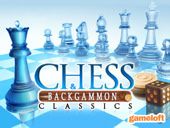By Brad Cook
Human beings have played games since the dawn of civilization, and none of them epitomize classic gameplay as much as chess and backgammon. The true origins of both are long gone, but the former can trace its lineage back nearly 1,500 years, while the latter was played in an earlier form over five millennia ago. Thanks to the digital age, you can now slip both games in your pocket; too bad you also can’t get in a time machine and awe a few ancient soldiers sitting around on guard duty.
Chess & Backgammon Classics feature competition against computer-controlled or human players, multiple levels of difficulty, static 2D or rotating 3D board views, various visual themes to choose from, and more. Each game also tracks your historical statistics, so you could wow those soldiers — or your friends, if you can’t find a time machine — with examples of your prowess.
Checkmate
When you select Chess Classics, you’ll also have the option of entering quiz mode or viewing classic matches, complete with commentary. Quiz mode presents you with 10 puzzles to solve, such as figuring out the correct move that will result in checkmate; your score depends on how quickly you determined the right answer.
The classic matches include such well-known battles as the split match between Anatoly Karpov and Garry Kasparov during the 1990 World Championship. You progress forward and backward through each contest one move at a time, with commentary appearing at key moments when the tenor of the action changed. You can even view a match played between early chess master Gioachino Greco and an unknown opponent during the 1600s.
The classic match commentary will help most chess players improve their games, but if you’re really inexperienced, you can also ask the computer for advice during a match. In addition to nine difficulty settings between “monkey” and “master,” you can give the computer one second, five seconds, or all the time it wants before determining a move. The faster it must make a decision, the greater the chance it will err.
The Priming Game
When you switch to Backgammon Classics, which you can do without quitting and reloading the game, you can opt to run through a tutorial, if you’re unfamiliar with the rules. You also have the choice of playing a quick game or a tournament against a computer-controlled opponent, in addition to the ability to take on a friend by passing your iPod back and forth.
The computer comes with three levels of difficulty — beginner, intermediate, and championship — and you have six visual themes to choose from: classic wood, magnetic, vintage, mechano, elegant leather, and fancy leather. Spin the click wheel to roll the dice and make your moves. There’s luck at play here, but there’s also plenty of room for strategizing too.
Chess and backgammon may be centuries-old games with long histories of classic contests, but this is your chance to add to that legacy on your iPod. Find a friend, or pick a computer opponent, and test your strategy skills.
The Ancient Art of Tabletop War
A 2004 archeological excavation in Iran unearthed the oldest backgammon set ever found, complete with a pair of dice and 60 playing pieces. That one dated to around 3,000 B.C., but most historians believe that Mesopotamia’s Royal Game of Ur and Egypt’s board game known as Senet, both of which have even older roots, likely influenced the invention of backgammon.
Early versions of the game differed from the modern edition — archeologists weren’t sure how the Iranian one was played — but the rules coalesced into their current state sometime during the Middle Ages, with the last major addition being the introduction of the doubling cube in New York City during the 1920s.
16th century Elizabethan laws prohibiting table games in England affected both backgammon and chess, which had come to Europe when the Moors invaded Spain in the eighth century; the Vikings later introduced it to northwestern Europe. The origins of chess likely lie in India, where a similar game known as chaturanga was popular; it came to Persia (modern-day Iran) during the mid-500s.
Russia, birthplace of many modern chess masters, received the game by way of China sometime before the eighth century. While the Chinese had made modifications to chess, including a river running through the middle of the board, European influences prompted Russians to play it the traditional way. The final rule changes that created modern-day chess arrived in the late 1500s, when players decided that the queen should be the most powerful piece on the board and that the bishop could move as far as possible along a diagonal line, rather than one space at a time.
Controversial chess grandmaster Bobby Fischer attempted to introduce his own version of the game, known as Chess960, during the mid-1990s, but it hasn’t become widely popular. Chess960 world championships have been played, however, and other chess variants also exist.
iPod Games FAQ
Do you have questions regarding any of the iPod games available from the iTunes Store?

Complementary Classics. John swivels the chess board and ponders his next move while Martha contemplates her backgammon inner board.
- Site: Chess & Backgammon
- Publisher: Apple Inc.
- Developer: Gameloft
- Genre: Cards, Casino, & Board
System Requirements
- Mac OS X version 10.3.9 or Windows 2000
- iPod nano (3rd and 4th generation only), iPod classic, or iPod (5th generation only). Not playable on your computer, other iPod models, iPod touch or iPhone. Please check which iPod model you have.
- iTunes 7.5 or higher required to download (games cannot be played in iTunes)

